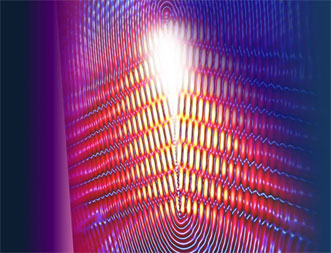Surface plasmons can exhibit wakes likes any other wave, and those wakes can be controlled through nanoscale features on a metallic surface and through properties of the light shining on it.
The creation and control of surface plasmon wakes could lead to new types of plasmonic couplers and lenses that could create 2D holograms or focus light at the nanoscale, according to researchers at Harvard University.
"The ability to control light is a powerful one," said professor Federico Capasso. "Our understanding of optics on the macroscale has led to holograms, Google Glass and LEDs, just to name a few technologies. Nano-optics is a major part of the future of nanotechnology, and this research furthers our ability to control and harness the power of light on the nanoscale."

An artist's rendering of a running wave of polarization that excites the surface plasmon wakes. Courtesy of Daniel Wintz, Patrice Genevet and Antonio Ambrosio.
Capasso's team generated running waves of polarization that propagated faster than the phase velocity of the plasmons along a 1D metamaterial. This created wakes analogous to those responsible for Cherenkov radiation.
The metamaterial, a nanostructure of rotated slits etched into a gold film, changes the phase of the surface plasmons generated at each slit relative to each other, increasing the velocity of the running wave. The nanostructure also acts like a boat's rudder, allowing the wakes to be steered by controlling the speed of the running wave.
The angle of incidence and photon spin angular momentum of the light shining onto the metamaterial determines the speed of the running wave of polarization and thus provides an additional measure of control. The team also discovered that using polarized light can even reverse the direction of the wake relative to the running wave — like a wake traveling in the opposite direction of a boat.
"Being able to control and manipulate light at scales much smaller than the wavelength of the light is very difficult," said graduate student Daniel Wintz. "It's important that we not only observed these wakes but found multiple ways to control and steer them."
The observation itself was challenging, as "surface plasmons are not visible to the eye or cameras," said Antonio Ambrosio, a postdoctoral fellow at Harvard and researcher at the Italian Research Council. "In order to view the wakes, we used an experimental technique that forces plasmons from the surface, collects them via fiber optics and records the image."
This work could represent a new testbed for wake physics across a variety of disciplines, the researchers said.
"This research addresses a particularly elegant and innovative problem in physics which connects different physical phenomena, from water wakes to sonic booms, and Cherenkov radiation," said Patrice Genevet, a former Harvard postdoctoral scholar currently affiliated with the Singapore Institute of Manufacturing Technology.
Funding came from the National Science Foundation and U.S. Air Force Office of Scientific Research.
The research was published in Nature Nanotechnology (doi: 10.1038/nnano.2015.137).
For more information, visit seas.harvard.edu.